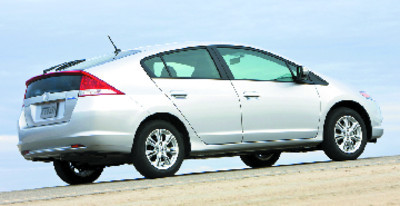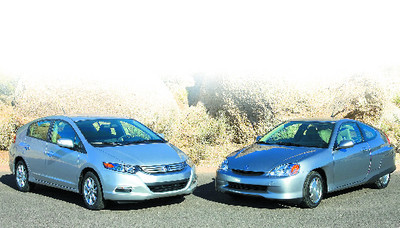Drive green, save green
The Insight is back with more power, a more practical design and a new mission as the most-affordable gasoline-electric hybrid on the block.
The original Insight, available from 2000 to 2006, was a fuel-sipping marvel. Unfortunately, its two-passenger capacity kept it in niche-market territory, while Toyota's category-leading Prius four-door hybrid hatchback stole the show. Meanwhile, Honda briefly tried marketing an Accord hybrid and continues to sell a similar Civic, but still trails the Prius by a considerable distance in terms of sales.
Honda is now pinning its hopes on a brand-new Insight squarely aimed at urban professionals seeking great fuel economy while helping to protect the environment. The Japanese-based automaker also hopes to appeal to the fearlessly frugal by keeping the sticker price in the $20,000 range (the actual price won't be set until closer to the Insight's launch on Earth Day, April 22).
As with the similar-looking Toyota Prius, the Insight has been designed for maximum practicality as well as fuel efficiency. The cabin feels particularly roomy and the storage space beneath the hatchback beats the current Prius by about 14 percent (Toyota will launch an all-new and enlarged Prius later this spring).
Although the Insight is a dedicated hybrid, which means it's not merely converted from another Honda model, its basic structure has been lifted from the entry-level Honda Fit and the view out the generously sized windshield is virtually identical. However, the car's aerodynamically shaped nose helps it slice more efficiently through the air, which increases fuel economy.
Motivating the Insight is an 88-horsepower 1.3-liter gas engine functioning with a 13-horsepower electric motor for a net total of 98 horses. By comparison, both the current Prius and the Honda Civic hybrid are each rated at 110 horsepower.
The power system is connected to a continuously variable transmission of a type favored by most hybrid manufacturers.
Fuel economy is estimated at a respectable 40 miles per gallon city, 43 mpg highway and 41 mpg overall. However, dash-mounted monitors encourage drivers to beat these numbers. The gauge display includes an "Eco Assist" speedometer that changes background color from blue (inefficient) to green (the most fuel efficient), depending on your driving style. When questioned why orange or red wasn't displayed for lead-foot types, Insight chief engineer Yasunari Seki said that he "did not wish to scold drivers" for their fuel-wasting habits, but use gentle persuasion to teach them.
The Insight also comes with an "ECON" button that, when pushed, induces the gas engine to shut down sooner when stopping, limits power and torque by 4 percent and runs the air conditioning and fan motor more efficiently.
Finally, an Eco Guide display rates driver performance by displaying an increasing number of "tree leaves" earned per trip as an indication of an efficient driving style.
During a 60-mile city/highway leg, the Insight achieved its estimated 43-mpg city rating for overall consumption, while a dedicated "hyper-miler" driving partner, using every fuel-saving trick imaginable, beat that number by nearly 30 mpg. With practice, and the help of the Insight's ever-present reminders about driving efficiency, it was easy to attain figures in the low-60-mpg range, but only by using the kind of slow-motion driving tactics that would aggravate most passengers and anyone sharing the road.
In the real world, the fully equipped base Insight LX proved a comfortable, capable and an enjoyable way to get around, while the optional EX added to the fun with cruise control, heated outside mirrors, upgraded audio system and an optional navigation package.
Honda has obviously tried to make the Insight appealing to all kinds of buyers and, if the company holds fast to its low-price approach, will no doubt entice many hybrid fanciers into the Honda camp.























